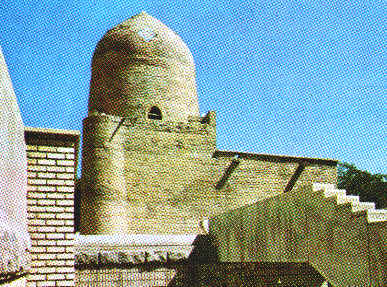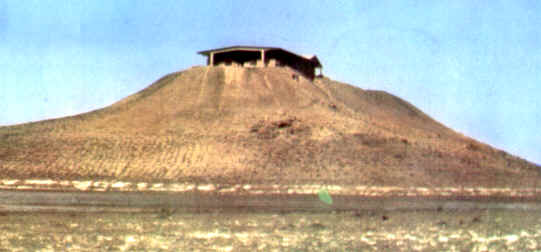
|
Hamadan's Historic Sites:

Giyan Hill After Nushijan, it is always possible to return to the main Hamadan-Kermanshah road through Touysekan and Godin excavation. But the journey through Malayer, which is well-known for carpets, Giyan Hill, Baba Jan Hill, Harsin and Ganj Dareh to Kermanshah is worth the effort. Combination of beautiful countryside set off by historical landmarks makes for very pleasant drive, and the whole journey to Kermanshah can easily be done in less than a day. To get to Giyan Hill, you must drive from Malayer toward Boroujerd and heading to Nahavand. This road also rejoins Hamadan-Kermanshah road, but at Nahavand a road heads West 33 km for Nur-abad and Baba Jan Hill. Before turning off at the main Malayer-Boroujerd road for Nahavand, there is again the choice of carrying on into Khoram-abad, the Heart of Lorestan. Both Boroujerd and Khoram-abad are pleasant towns, with a number of interesting mosques and tombs. From Khoram-abad, where citadel from its days of fame as "Black Fortress" still survives, it is possible once again to reach Kermanshah, by way of Baba Jan, Harsin and Ganj Dareh. Giyan Hill is Southwest of Nahavand, at the side of a road turning West from the main road. the site of this ancient settlement, which may have been destroyed by Assyrian, almost 1000 BC, is believed to have been habituated from 5000 BC on. Many items of pottery, vessels and goblets were discovered here, as well as valuable grave sites. Mausoleum of Ester & Mordekhai The principal attraction of this curious tomb is that it was believed to contain the remains of Biblical Ester, the Jewish wife of Xerxes and her uncle Mordekhai. Ester was in fact buried in Susa, and this tomb probably belongs to another Jewish queen, Shushan-Dokht, wife of one of the first Sassanian kings, Yazdgerd I (399-420 AD). The mausoleum is entered through rough stone door, which swings open into large assembly room. Another smaller chamber, facing the twin tombs, is used for prayers aided by ancient Torah on vellum. The two ebony tombs are covered with striking collection of colorful clothes. A religious relic left back to the Jewish community in Hamadan is the mausoleum of Ester and Mordekhai. This monument is visited every year by Jewish pilgrims. Jewish religious ceremonies are held in it. These ceremonies, known as "Purim Feast", are held in mid-March (Adar 13-15th) to commemorate the salvation of Jewish community by Ester, the consort of Xerxes (486-445 BC) and her uncle, Mordekhai, and comprises prayers, fasting and readings of Magila scroll and ends with giving presents and visiting one another in festivities. 
According to historic narratives, Hadassa was Jewish girl, who came to known as Ester (star) for her beauty. She was selected the queen of Xerxes, third Achaemenian Emperor. Mordekhai was the son of Panir, from the tribe of Benjamin, uncle of Ester and guardian of Acheamenian Court, in Sussa, who introduced Hadassa to the court. Haman, the minister of Xerxes, was planning the massacre of Jewish community in Iran, as people always did in the during of the history. Moredkha, who had become aware of the plot, informed the king of scheme; so, Ester married to Xerxes, to prevent the scheme. Owing to their position in the court, Ester and Mordekhai were able to save Iranian Jewish community and this mausoleum was later built in their honor, becoming an important pilgrimage point of Iranian Jews. The square domed brick building dates back to 13th century AD and was built on the site of an earlier building erected upon the order of Mongol Arqun-Shah. This mausoleum is accessed through a hasp-equipped stone door so shallow that one has to bend (to respect) to enter the building. Past the entrance, there is 7x3 Sq. m. North-South oriented room, with centrally located door, leading to the shrine proper, which has 3.5 Sq. m. plan. Two superb engraved wooden cases, made by Enayatolla ebn Hazrat-Qoli Touyserkani, are visible there. These cases are located side by side, covering the graves of Ester and Mordekhai. Brick dome tops the shrine and its inner walls are covered with large and small stones and stucco inscriptions in Hebrew and Aramaic scripts. As concerns the antecedents of Jews, settlement in Iran, Their Book says: " And the king of Assyria had Israelites migrate to Assyria and settle in Halah and Khabur, at Nahr Jowsan." Following his military campaign in to Baylonia, Cyrus the Great (559-530 BC) set free the Jews whom Nabuchadnezzar, the king of Baylonia, had captured in Palestine and taken to his realm. As the famous cylindrical seal of Cyrus attests, the order allowing their return to Jerusalem was issued in 537 BC. It appears that, following this order, number of them accompanied the king on his way back to Iran and settled in Sussa, Isfahan and Hamadan. In 2002, 22 Jews live in the city of Hamadan. Nushijan The unique Median (800 BC) excavation is the first of several important sites along the Southern loop from Hamadan to near Kermanshah. Median's oldest Fire Temple is located here. Noushijan mound rises conspicuously at the center of flat bowl ringed by hills, and is within sight of Hamadan-Malayer road, just under 15 km before Malayer. The temple and adjacent fort, erected in 8th century BC, are brought to have been abandoned after 6th century perhaps briefly reoccupied in the first century BC. 
What these building show is the growing architectural sophistication of Median, settling in their new homeland, on Iranian plateau. The triangular temple room is part of lozenge-shaped floor plan for the central building, and is decorated with blind windows and recessed crosses. Fire altar is visible on West side of the room. Among the objects discovered at Nusheh-Jan was copper bowl, filled with over 200 silver items, such as spiral beads, ingots and scraps of metal. Ghorban Tower It is visible from the high point of Stone Lion. This 12-sided conical 13th century tomb-tower attracts pilgrims from the city and its environs. 
|
© Copyright Caroun.com. All rights reserved.